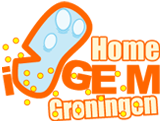Team:Groningen/Project/Lab plan
From 2009.igem.org
Lab plan:
- Clone gvp from BioBrick (BBa_I750016) in vector with inducible promoter (e.g. PAra)
- Clone a metal ion transporter (CitM and HtmA are planned)
- Clone a metal accumulating protein.
- Clone a metal sensitive promoter in front of the gvp cluster.
- Clone the metal accumulating protein and metal transporter in one vector, possibly on a synthetic operon
- Transform both vectors in one E. coli strain
Wk1
Gvp Cluster
- BBa_I750016 is a construct: E-genR-X-RBS-PART-S-P in vector BBa_J61035.
- Possibly the AmpR and ColE1 are also still present on the vector, as the part was last checked in 2008 and contained a Amp resistance marker…
- The part is present in the microtiter plate: Kit Plate 2, Well 11A
- Quality control was okay, but plasmid length was different than expected. --> should be checked by us.
- Plan:
- Get chemically competent E. coli
- Dilute dry DNA of gvp with 15ul diH2O
- Transform to E. coli --> see protocol
- Plate on LB-A plates with Amp or Gentamicin selection (50/50)
- Use positive and negative control
- Grow o/n @ 37 degrees
- Pick single colony and grow o/n in 5ml LB + correct antibiotic
- Make glycerol stocks of the o/n culture
- Do DNA isolation
- Check the vectors insert by restriction analysis --> PstI and XbaI (would give 1 band of ~ 3539bp and 1 of 6064bp)
- Design primers to get rid of restrictionsites
CitM
- SJ transformed E. coli with pWSK29, a low copy nr vector containing CitM (according to B. Krom this is the best vector for CitM)
- Get plasmid and possibly the plate with E. coli transformants.
- Check expression of CitM while growing on citrate medium with Amp, induce with IPTG
- Check gene for restriction sites and design primers to get rid of restriction sites.
- Design primers to introduce a pre/suffix --> ask B. Krom whether this would be feasible
HtmA
- On its way, but hopefully arrives next week
Accumulation of metal
- BioBrick (BBa_K129004) LamB + metal binding domain is not available
- Find out whether it’s possible to only express the metal binding domain (6AA) and if so, order synthetic DNA with part with pre/suffix
To do list
- Get CitM from the biological centre
- Finish equipment list --> send to facility manager
- Design primers
- Read articles to find modeling parameters for the different sub-projects and to find testing-phenotype (e.g. metal inport) protocols
- Start ordering materials like: media, restriction enzymes, kits
- Talk with Profs for permission to use stuff from the different groups in Haren
- Check compatibility of different plasmids / promoters / replicons in E. coli--> On Fermentas site about pUC18, pUC19 and about pACYC184
- Make a plan for July, concerning:
- Vector --> how to get the pBS3K1 empty, what kind of vector is pWSK29 (Frans)
- Primers --> how to remove restrictionsites in gvp, possibly in CitM / HtmA (PstI) (Frans)
- Promoters (Frans, Michael)
- High/moderate/low expression upon induction or constitutive
- Metal sensitive promotor
- cloning facilitation tools
Wk 2:
- Get everything in the lab
- Have BioBricks checked on correct insert
- Have primers ordered
July:
GVP (2 people)
- Test insert length of gvp cluster
- Clone gvp from BBa_J61035 to another vector with p15A vector (pBS3K1)
- Clone gvp in vector with different promoters; high, moderate, low expression…
- Silence restriction sites in gvp cluster by PCR (which?)
- Test phenotype, growth rates E. coli --> which of the promoters is the best one?
- Check compatibility of gvp expression and CitM expression in E. coli by transforming the organism with both vectors and select on two antibiotics (compatible selection markers and promoters)
Metal transporters (3 people)
- CitM
- Transform E. coli with pWSK29
- Test phenotype, expression, check growth rate while expressing CitM
 "
"
